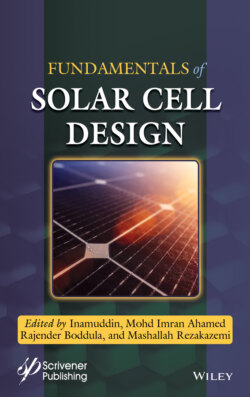Читать книгу Fundamentals of Solar Cell Design - Rajender Boddula - Страница 30
2.1.1 Plasmonic Nanostructure
ОглавлениеThe specific wavelengths of light spectrum make the conductive electrons to oscillate collectively in the metal. This phenomenon is known as plasmonic resonance or surface plasmon resonance (SPR), which is schematically shown in Figure 2.2. Plasmon resonance of free electrons in metal nanoparticle is basis of the plasmonic effect. SPR wavelength is depending on the medium, size and shape of metal nanoparticles. SPR excitations increase more absorption and scattering of light compared to nonplasmonic nanoparticles [18, 19]. The optical properties can be tuned to absorb wide range of light spectrum of the electromagnetic radiation by tuning the thickness, size, shape, and composition of nanostructure. The reflecting color also can also be tuned by shifting the scattering and absorption, for example, solutions of gold and silver nanoparticles have ruby red and yellow color due to strong scattering, respectively [20, 21]. The resonance wavelength of plasmonic nanostructure is influenced by the refractive index (n) of material, for example, peak resonance of Ag nanoparticles (80 nm in size) in water (n = 1.33) is at 445 nm and in air is about 380 nm. This theory was explored by Mie theory that can be used to analyze the scattering from spherical particle at any wavelength of light [22, 23]. The coupling effect in plasmonic nanoparticles is responsible for the shifting in absorption and color of particles. The scattering by the metal nanoparticles is more important than the absorption of light in plasmonic solar cells and hence plasmonic nanostructures have emerged as promising candidate to enhance the characteristics in solar cells, detectors, and sensors. The plasmonic nanoparticles of silver (Ag) and gold (Au) are mostly used at the top of the surface of PV device because of their SPR exist in the visible range. Al nanoparticles show SPR in UV range but they are unable increase the efficiency in plasmonic solar cells [24].
Figure 2.2 Schematic representation of surface plasmon resonance.
